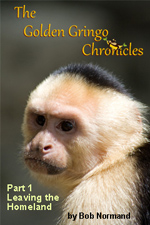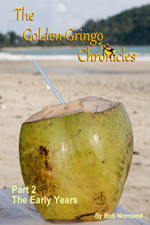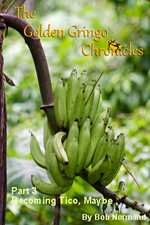Broken News
(All the News That's Fit to Reprint)
Designing Excellence
Beginning with the April 2015 edition the Chronicles has once more made improvements (GG thinks). The Chronicles are taking on a new, fresher and cleaner look. The style also compliments our new website, www.goldengringo.com.
 |
Tammy Adkins |
GG has had websites, both business (www.isbminc.com) and personal (www.bobnormand.com) for almost 15 years. The Golden Gringo Chronicles website is just another addition to the stable. While I have done some of the basic construction of the format and just about all the editing of content for the Chronicles, I also have worked periodically with a lady, a professional website designer, who used to be based in Sarasota but who now lives near Asheville, NC. In this type of work it really doesn't matter where you're based, does it?
Her name is Tammy Adkins and she was again involved in the format changes seen here. Tammy's grasp of how to put together a good website, particularly with Dreamweaver, is far reaching and her work product is excellent. I can easily recommend her.
If you need some work done, or have been toying with the idea of putting up a website, you can contact Tammy here:
Tammy Adkins
Freelance Web & Graphic Designer
Tel: 330-936-0992
swsdesigner@yahoo.com
Paving Progress
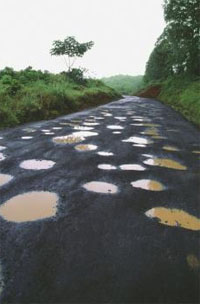 Costa Rica is no stranger to rough roads (see article on Cerro de la Muerte below). Rainy weather here takes a heavy toll on our streets and highways every year. There are potholes and wash outs galore caused by heavy rains. The photo on the left is not an unusual depiction of a secondary road, nor an unpaved Quepos street for that matter, in rainy season.
Costa Rica is no stranger to rough roads (see article on Cerro de la Muerte below). Rainy weather here takes a heavy toll on our streets and highways every year. There are potholes and wash outs galore caused by heavy rains. The photo on the left is not an unusual depiction of a secondary road, nor an unpaved Quepos street for that matter, in rainy season.
|
Barrio Los Angeles - Before |
|
Barrio Los Angeles - After |
The Chronicles has reported on driving adventures before (see Potholes and Wormholes and Visiting the NIcoya) and the article below describing the "Hill of Death" section of the Interamericana which passes through Costa Rica is just another chapter. Yet, the country has made real progress in recent years in highway infrastructure and in improving and paving local roads.
So it was not without a certain excitement that GG saw the Quepos Municipalidad boys moving in to begin paving the streets in my little neighborhood, barrio Los Angeles. Somehow our neighborhood was one of the last areas in the town to receive this treatment (a result of local political effrontery not yet identified, perhaps?).
I've lived here for six and a half years and our barrio only received an annual grading of the gravel streets to fill in the potholes with gravel before rainy season hit and the degradation process started once again. But this time we got a grading, tamping of the gravel layer with a industrial roller and a layer of asphalt. The tamping shook my apartment and at first I thought it was another tremor (living on the rim makes one a bit sensitive). The paved street is shown in the photo lower right.
Zowie, no more potholes and even more importantly, no more dust, which is rampant during the dry season. Vehicles going across the asphalt are also a lot less noisy than they were running across the gravel. All in all, a considerable improvement.
I know, you first-world country types are laughing and smirking about a road surfacing project being the subject of celebration. Drive the southern Nicoya peninsula dudes, then we'll talk some more.
¡Pura Vida!
Ditch Drama Continues
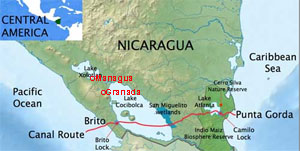 Ostensibly, the project to build a $50 billion new canal in Nicaragua, designed to put it in direct competition to the Panama Canal, is going forward. The original cost estimate was $30 billion, then it was $40 billion, now it's $50 billion. In all likelihood it will be $100 billion should it really be constructed.
Ostensibly, the project to build a $50 billion new canal in Nicaragua, designed to put it in direct competition to the Panama Canal, is going forward. The original cost estimate was $30 billion, then it was $40 billion, now it's $50 billion. In all likelihood it will be $100 billion should it really be constructed.
The Chronicles has been following this project since 2010 when Nicaragua ripped off a portion of Costa Rica at it's northeastern tip and then shortly afterward announced the new canal project. As it turns out, the latest route for the canal that has been chosen (see map right) doesn't use the land that was annexed (so give it back to Costa Rica Danny Ortega!). More background info on this project can be found here: Nica Canal Update, & More Ditch Drama.
The new route is now causing great concern because it requires dredging through at least two major lakes including Lake Cocibolca, better known as Lake Nicaragua, which is described by some as "Central America’s main freshwater reservoir and the largest tropical freshwater lake of the Americas". Environmentalists are raising strong concerns that a project of this size and scope will create an ecological disaster, both in the digging of it and in its later operation as constant dredging to keep the channel open will churn up sediment in the lakes that kills marine life.
But Mr. Ortega is not easily swayed from his course. He believes this project will create the base for strong economic growth in the future. Might it not also overwhelm your economy, Danny? Nicaragua is second only to Haiti as the poorest country in Latin America. On a proportionate GDP basis, the $50 billion cost of this project would be a $275 billion project in Costa Rica and a $78 trillion project in the U.S. That kind of fiscal impact sounds like numbers that would sink any country. The cost is passed off by supporters and critics alike - "the Chinese are paying for it." Really? Wonder what they're interested in getting for their investment; certainly cheap passage is unlikely under the estimated cost burden.
The saga continues.
The contractor, Hong Kong Nicaragua Canal Development Group, is "reportedly beginning the construction of roads to move heavy equipment and supplies into place" so that the project can begin.
Vying for Bottom Place
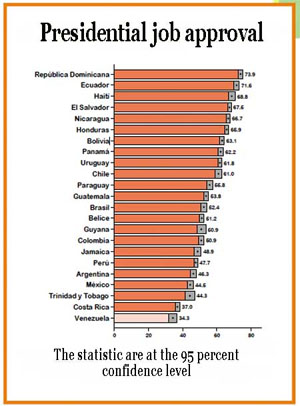 An English-language online newspaper here recently reported that a ranking of presidential approval levels put our man Solis second to the bottom after Señor Maduro of Venezuela (see chart right).
An English-language online newspaper here recently reported that a ranking of presidential approval levels put our man Solis second to the bottom after Señor Maduro of Venezuela (see chart right).
The survey was conducted by something called the Latin American Opinion Project at Vanderbilt University (sounds like a grad student thesis project to me).
It was no surprise that Venezuela's president was placed in the pits (approval rating = 34.3) as the country's economy is also: inflation rates higher than 60%, wide spread shortages of food and other basic items, growing civil unrest that included Maduro's jailing of his strongest political adversary and a murder rate that is approaching the worst in the world.
What did surprise GG however, was that Solis came out so poorly (rating of 37.0) considering he had only been in office some seven months before the survey was published. Come on amigos, give the dude a chance.
Sure enough, a couple of weeks later the newspaper had to publish a correction that the survey was actually done in April 2014, a month before Solis took office and that the survey was actually measuring his predecessor's performance, Sra. Laura Chinchilla. Sorry Laura, no Oscar for you on this one and Solis is still in the running for the next rating.
Quepos Quickies (Heard on the Street)
-
It took a tourist to ask the right question. The answer is that Manuel Antonio National Park, unlike in the past, is now open on Mondays, meaning it's available
to visitors seven days a week. Evidently, this change in policy was something required by the San José government as a result of them recently approving a hike in the entrance fees. Tourists will like this new schedule because learning late in a vacation that the
park did not
open on Mondays had often caused considerable disruption in plans to see the area in a short time. To my knowledge, the Monday closures were never widely publicized.
-
During a recent walkabout in Quepos, GG noticed activity at the old location of the El Gran Escape restaurant on front street. That restaurant had been an icon to visitors for many years. GG approached a gent working there to ask what was going on. Turned out he was the new owner, a dude from Argentina named Pablo. Pablo said that yes, indeed, the new El Gran Escape would be opening shortly and he made a point that several of the old EGE chefs would be returning. The mouth begins to water.
-
Walking up the street from the new El Gran Escape the same day, GG noticed a new restaurant sign hanging from the second floor of what used to be called the Centro Commerciale La Garza. The new restaurant is called "Blue" and on the sign it claims the "Best Ceviche Award". Doesn't say who bestowed the rating. We'll have to see. Ah, the work of the ROMEOS is never done.
TOP
Rumble Talk
(Eruption Flare-Ups at Turrialba)
The warnings from experts started months ago and continued into early March, say the experts: Turrialba, a currently active volcano located in the central mountain spine east of San José, is likely moving towards a "significant event", as the euphemism goes.
How did they know something would be coming? Said the Comisión Nacional de Prevención de Riesgos y Atención de Emergencias (National Commission on Prevention of Risk and Emergency Preparedness): "The commission is basing its efforts on a study done of material ejected from the volcano last Oct. 29. The material contained magma that is suggestive of an eventual full-scale eruption. The material shows that magma is moving toward the surface".
On Thursday, March 12, the volcano proved them true when the volcano erupted three times within four hours, each event lasting 30-50 minutes. In each case ash-laden gas spewed up to two miles into the air. People in the central valley around San José experienced some dusting on their autos and property, although the particles were so fine as to create minimal ground-level dusting from the cloud beyond a perimeter of two kilometers from the volcano. Prevailing winds moved the clouds westward across San José and then into the Pacific, where most of the fall-out will occur.
The next day the eruptions continued. Fortunately, many people who had been living near the volcano had moved or were evacuated some time ago. The activity caused some chaos nevertheless with the regional airport at Pavas (Tobias Bolaños) as well as the main airport in Alejuela (Juan Santamaría) being shut down for part of the day, some flights being rerouted to the Liberia airport in northwest Guanacaste.
Stay tuned, to be sure, there's more to come, it's just a question of when.
Check Out Recent Earthquakes Around the World
Posted by the U.S. Geodetic Survey: Today's Quakes |
TOP
Prisoner #1713
(How to Become a Writer - the Hard Way)
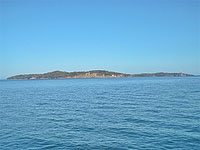 The Chronicles published an article last month concerning a visit to the southern Nicoya (Visiting the Nicoya) in which we reported seeing some beautiful islands on the ferry route between Puntarenas and Paquera. GG didn't realize until later that one of those pristine islands we passed was Isla San Lucas, an infamous former prison island (photo right).
The Chronicles published an article last month concerning a visit to the southern Nicoya (Visiting the Nicoya) in which we reported seeing some beautiful islands on the ferry route between Puntarenas and Paquera. GG didn't realize until later that one of those pristine islands we passed was Isla San Lucas, an infamous former prison island (photo right).
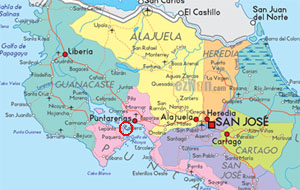 |
Isla San Lucas (Red Circle) |
Unfortunately, prison islands have not been uncommon in Latin America, the most notorious being Devil's Island in French Guiana, South America. The Chronicles also reported on another of the more infamous ones back in September of 2014 that is located near the northwest tip of Panama on the Pacific coast (see Isla de Coiba).
The Costa Rican version of the prisoner island is Isla San Lucas in the bay of Nicoya (see map).
Isla San Lucas came to GG's attention when a waiter at a restaurant in Montezuma heard us talking about the islands we had seen on our trip and slipped GG a one page flyer with the provocative title "Prisoner # 1713". Prisoner #1713 was a Costa Rican inmate at San Lucas from 1950 to 1969 and was known by name as José León Sánchez Alvarado. His story is too interesting a part of modern Costa Rican history to pass it by.
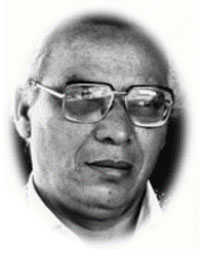 |
José León Sánchez A.
(At the Height of
His Writing Career) |
León was born into extreme poverty in 1930 in the town of Cucaracho (yes Dorothy, that means cockroach) del Rio Cuarto near the Costa Rica/Nicaragua border. He was an indígena, a native "indian", of the Huetares tribe. His indigenous name ¨Ocelotl¨ means ¨leon¨ in Spanish or lion in English (actually the name comes from a local wildcat, the ocelot).
He was baptized by a Catholic priest and inherited his last two Christian names from the village of 700 hundred people where he was born, which was called Sánchez Alvarado. Hence, his name became José León Sánchez Alvarado. There were many children in his family but they were so poor that, in order to survive, the women in the family, including León's mother, prostituted themselves by servicing the local huleras, workers who specialize in extracting sap from rubber trees.
As a result, León would never come to know
his father or even who he was. As a young boy, León was traded to a salt merchant for a sack of salt but the merchant eventually dropped him at the Hospice for Orphans in San José because the boy was sickly. A year later the boy escaped the orphanage with his sister. The sister went on be a prostitute from the age of 14, eventually dying at the hands of her husband. León would immortalize his sister's experience later in a short story and book, that would be published in 160 languages by Unesco. It was called "La Nina que Vino de la Luna" (The Girl Who Came from the Moon).
 |
Basilica de Los Angeles |
In 1950, at the age of 20, León's life would be changed forever. In the nearby city of Cartago, the original capital of Costa Rica, a sensational burglary occurred at the Basilica de Los Angeles. This site is considered by Costa Rican Catholics as the holiest place in the country and the home of La Virgen de Los Angeles, the country's patron saint. There is an annual pilgrimage to this site that attracts over one million people (over 20% of the Costa Rican population) and it's also the home of a small black stone statue called La Negrita that is revered by the populace as miraculous.
So when in May of 1950 the Cathedral was robbed of jewels worth more than a million dollars that decorated the statue of La Virgen de Los Angeles and a guard murdered, there was great public outrage. The authorities response was to bring in a special police force from Cuba to investigate and, for reasons that are still unclear, they arrested young León and subsequently tortured him by forcing pins and toothpicks into his ears and into a decayed tooth. As expected, this treatment quickly produced a confession by León that he had been the perpetrator of the crime.
 |
Entry Dock at Isla San Lucas |
 |
Center Square Torture Circle |
 |
Anthropologist Studying Remains
in the San Lucas Cemetery |
León was soon found guilty and was
sentenced to life imprisonment on Isla San Lucas, The public dubbed him "El Monstruo de la Basilica" (Monster of the Basilica) and he became the most hated person in modern Costa Rican history. Most lawyers would not defend him and jointly signed a document stating that they would accept any punishment they could receive before defending the Monster of the Basilica. The Catholic Church excommunicated him.
León was marked on his chest as "#1713" and sent to Isla San Lucas, a hell-hole by anybody's standards, where food was eaten without a plate or cup and the bathroom facilities consisted of one corner of the cell. León would be imprisoned in San Lucas until 1969, a full 19 years. During his stay there, León would go on record as having attempted escape nineteen times, an average of once per year. In only two of these attempts would he reach the mainland, only to be captured and sent
back to the island. He was beaten and tortured for his attempts.
While at San Lucas, in between escape attempts, he encountered a couple of inmates that taught him to read and write. He proved to be a good student and quick learner. In turn he would write letters for his fellow inmates who could not read nor write. León wrote many letters for prisoners (at 5 centavos each) and this gained him knowledge of the history and background of many of the inmates, knowledge that would become important to his later writings.
In 1963, at the encouragement of fellow inmates, León entered a writing contest
run by the University of Costa Rica and won the main prize of 2,000 colones, a princely sum at the time (there were about 4 colones to the dollar back then). His short story was called : "The Poet, the Child and the River". Because of the controversy surrounding the most hated criminal in Costa Rican history, the prize was awarded at the Teatro Nacional to an empty chair. His reputation took a quick turn and he then became famous to his fellow countrymen not as "Monster of the Basilica" but as the "Insane of the Book".
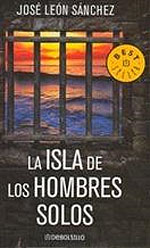 Even before his win of the writing contest, León set out to write a novel using pencils that were smuggled in to him. For stationary he used leftover cement bags. After ten years more and his eventual freedom he would produce his first best seller called La Isla de Los Hombres Solos (The Island of Lonely Men) all about his and other inmates' experiences at San Lucas. It remains his first significant writing and his signature work along with a second novel called "Tenochtitlan: The Last Battle of the Aztecs".
Even before his win of the writing contest, León set out to write a novel using pencils that were smuggled in to him. For stationary he used leftover cement bags. After ten years more and his eventual freedom he would produce his first best seller called La Isla de Los Hombres Solos (The Island of Lonely Men) all about his and other inmates' experiences at San Lucas. It remains his first significant writing and his signature work along with a second novel called "Tenochtitlan: The Last Battle of the Aztecs".
Eventually León would sell over 2 million copies (!) of the Solo book and one and a half million of Tenochtitlan. He would go on to write some 27 books and became the outstanding author of Costa Rica in the twentieth century (which essentially means ever). He also has received numerous awards internationally and in his home country. His books have been translated into English, Italian, Russian, German, Dutch and French. (Just for fun, I Googled Amazon about his Solo book, which is now out of print, and found a used copy going for $128.22)
 |
Recent León Photo |
In 1980, the Costa Rican high court declared León's conviction null and void because of the use of torture. The ruling meant that he was finally and completely exonerated.
The 1,250 acres of Isla San Lucas, complete with decaying structures, has been declared a national refuge and heritage site and turned into a National Park. Tours are available for those interested and leave from Puntarenas. The park has 17 species of reptiles, 8 species of mammals, medium and large, 40 species of birds, with two species of mangroves and 63 species of marine fish. It also has those white sandy beaches that GG found so attractive.
Señor León, by my arithmetic, is now in his eighties and reportedly living in Heredia, not far from San José. That's a recent picture to the right. You are an incredible man indeed, señor.
My oh my, what some people are willing to go through to sell books.
¡Solo Bueno!
TOP
Cerro de la Muerte
(Riding the Mountain of Death)
The Interamericana Highway, also known as the Pan-American Highway, (see Road to Everywhere) slashes through the heart of Costa Rica, entering the country at the Peñas Blancas border with Nicaragua in the northwest and exiting at the Paso Canoas border with Panama in the southwest.
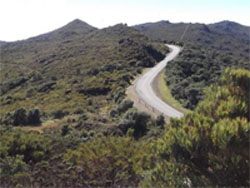 |
Cerro de la Muerte |
The entire highway runs from the Arctic at Prudhoe Bay in Alaska all the way to Ushuaia, Argentina near Tierra del Fuego, the southern most tip of South America and a hop, skip and jump from Antarctica. Indeed it goes virtually everywhere in the Americas and one can virtually travel from the North Pole to the South Pole on this highway.
Part of the Interamericana in Costa Rica negotiates a mountain pass called Cerro de la Muerte (mountain or hill of death), the highest and potentially most dangerous road in Costa Rica. A friend of GG's recently had an experience there and shares her adventure with us in her own words in the article below (pictures and captions courtesy of GG):
Driving the Cerro de la Muerte
Know Before you Go
If you’re the adventurous type and would like to drive the Cerro de la Muerte (“Mountain of Death”) there are a few things to know before you go. This section of the Inter-American Highway got its name because in days gone by, traveling over the Talamanca range at altitudes reaching 3,451 meters (11,322 feet) was a perilous and sometimes fatal endeavor.
It may be hard to imagine that there are so many potholes on a major artery through the Americas, and of such great size! Make sure your spare tire is aired up. Bring everything you need to change a tire under adverse conditions.
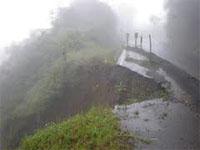 |
Rainy Season on the
Cerro de la Muerte |
Weather and road conditions can change rapidly. In January 2015, the northbound lane on the Cerro de la Muerte gave way, sweeping a driver and his vehicle down the mountain. The motorist survived, clambering up through the mud to the undermined roadway.
Keep in mind that, even if there’s no place to pass, drivers will do so with little or no thought. Double yellow lines are merely advisory (as elsewhere in Costa Rica.)
Things to know if you have car trouble
 |
Of Course the View is One Reason
Why People Travel the PA
(that's not snow - just mist) |
I've only been on the Cerro de la Muerte once, around Christmas 2014. That one time was enough to learn what to expect if your radiator hose springs a leak and your car overheats, as you cross the steep mountain range.
There may not be a place to pull off the highway. Deep concrete drainage ditches line both sides of the roadway and you can crash into the side of one if you leave the pavement. There’s no shoulder. The pavement ends with the fog line (if any.)
Figure on no cell service. The cheaper the phone, the less chance that you will get a signal.
It’s very cold. Wind may be blowing the pelting rain sideways. Bring plenty of warm clothing, and put on all that you have before you become chilled, including boots and a complete set of waterproof clothing.
There’s no highway patrol cruising the de la Muerte looking for stranded travelers. Somebody looking for stranded travelers is looking for a victim.
If you try to hitchhike to find help, there may not be a place for people to stop to pick you up that isn'’t dangerous, for them and for you. They may be more scared than you are. Although you've bundled up against the cold, remember to remove your hoodie if you want people to stop. It’s more likely that you'll get a ride if you hitchhike alone, and leave the others with the car. If your party must split up, make sure that someone in each group speaks Spanish very well.
If you choose to hoof it and it’s getting late, know that long stretches of the Cerro de la Muerte have no streetlights at all. There aren'’t any businesses or services, not for many, many kilometers. Bring the fully charged flashlight that you always have in your car. One comes in handy if you stay with the car, too, so if someone in your party stays with the car, take out that second flashlight with fresh batteries that you keep in the glove box.
If you have roadside assistance through INS (the national insurance institute) make sure that you have the emergency phone number. If you must abandon the car to find cell service, write down the license plate of your car and bring it with you. You will need it to make a claim. Bear in mind that assistance in this part of Costa Rica may be unavailable until the next day.
If helpful Ticos offer to tow your vehicle, odds are that it will be towed with a chain. Chancy enough where the road is level, this towing method is even trickier where the road is narrow, twisting, congested, dark, foggy, and especially if you don’t regularly drive this route.
While these Good Samaritans are wrapping the chain around your bumper in the middle of the lane, look both ways, and warn big rigs and cars barreling around the bend bent on making time.
Once you are under way, work the brake to avoid colliding with the back of the truck. Proper steering is essential. Honk several times if you aren'’t comfortable with this method of transport. The driver may stop in the roadway on a blind curve, and come back to find out what is wrong. Rest assured that the driver will pull over as soon as it is somewhat safe. It may take a while to find the right place, so be patient.
Other measures you can take before you go -
.
Pull in and fill up at that last chance gas station. You'’ll be glad you did, especially if a situation develops.
Carry a spare radiator hose, coolant, brake pads, electric wiring, duct tape, headlight and taillight bulbs, windshield wipers, food and water, car battery and anything else that you think that you might need during your travels over the Cerro de la Muerte.
Have a safe trip, and keep your eyes on the road!
Editor's Notes
Muchas gracious and many thanks to our reader and contributing writer for this article and the good advice on how to stay safe. Having driven recently on some of Costa Rica's "country roads", GG can vouch for the need to be careful and cautious. The life you save may be your own. There was a "derrumba" (landslide) in February that required deviating along secondary roads around a lengthy section of the Americana not far from the Cerro de la Muerte. A recent report in AM Costa Rica said work on replacing this section has now been complete, after a month of this important highway being out of service.
The saga continues.
TOP
Jungle Jessie
(When Saving Lives is Not Just a Job)
GG doesn't know if he coined the word or not, but he believes he is now, and always was, a beachophile, someone who loves beaches. Why? Because they've played an important part in his life since he was in pre-school (we used to call it kindergarten); see Life's a Beach.
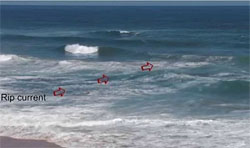 GG learned early in life, around the age of 11 or 12 that large bodies of rapidly moving water are to be respected. Here's an example: once, he and some buddies decided to go swimming near where he lived in Massachusetts just one day after a hurricane had passed through the area. The waves were running 10-15 feet and looked like fun. At one point he was pulled out by a rip current and might have ended up as driftwood on a beach somewhere in New Jersey had it not been for an alert lifeguard who had no qualms about diving into the rough surf and snagging the hapless, struggling kid who would later become the Golden Gringo. Good job, amigo.
GG learned early in life, around the age of 11 or 12 that large bodies of rapidly moving water are to be respected. Here's an example: once, he and some buddies decided to go swimming near where he lived in Massachusetts just one day after a hurricane had passed through the area. The waves were running 10-15 feet and looked like fun. At one point he was pulled out by a rip current and might have ended up as driftwood on a beach somewhere in New Jersey had it not been for an alert lifeguard who had no qualms about diving into the rough surf and snagging the hapless, struggling kid who would later become the Golden Gringo. Good job, amigo.
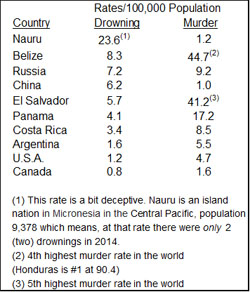 Death by drowning is more common than some people might think. According to the World Health Organization: "Drowning is the 3rd leading cause of unintentional injury death worldwide, accounting for 7% of all injury-related deaths. There are an estimated 372,000 annual drowning deaths worldwide." Some drowning "rates" for selected countries are shown on the table to the left.
Death by drowning is more common than some people might think. According to the World Health Organization: "Drowning is the 3rd leading cause of unintentional injury death worldwide, accounting for 7% of all injury-related deaths. There are an estimated 372,000 annual drowning deaths worldwide." Some drowning "rates" for selected countries are shown on the table to the left.
For an interesting comparison, murder rates are also shown and it was a bit surprising that drowning rates in some countries (Russia for example) were nearly as high as the murder rate (too much vodka in either case, maybe?) or even higher, like in China (I must say that I'm skeptical of the data that says China has one of the lowest murder rates in the world). The murder rate in tiny Nauru suggests they suffer one murder every ten years.
Unfortunately, statistics say that over half of the drownings worldwide are small children between the ages of one and four years. Although I'm not aware of that statistic playing out on our local beaches, I have been witness to many instances where small children (ages 2-10) are not well supervised at the water's edge. I attribute this partly to the more open, trusting nature of Ticos and also because many of them (people from the central valley or mid-west U.S., for example) are not familiar with the dangers of the sea. That applies to both playing in the wave backwash and being unaware of rip currents, which are common in Manuel Antonio, particularly on outgoing tides.
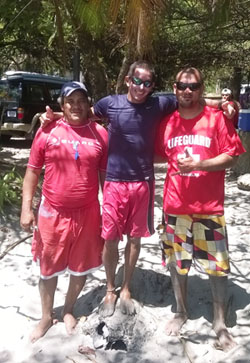 |
Three of Our Beach Heroes; left to right: Roberto ("Monchito"), Johnny ("Juancho") and Jessie ("Jungle Jessie") |
The Chronicles has pointed out before the good work our lifeguards, our salvavidas, do at Manuel Antonio beach. There are a handful of young men who work at the beach in various capacities and at the same time fill the lifeguard role. Three of our good guys are shown in the photo to the right; you'll find them perched along the shore in front of the tree line at the May y Sombra area just south of the Balu Restaurant. Together with the other boys on the beach who work there, they claim 37 extractions from the surf in 2014 alone.
Roberto, age 51, known as "Monchito" (see What's-in-a-Word section below for the derivation of this nickname) has been acting heroically on behalf of visitors for 33 years, since he was 18. He claims that in 1980 he helped pull a gentleman from a rip current who turned out to be one Rodrigo Carazo Odio, who also happened to be the president of Costa Rica at the time.
Johnny, also known as "Juancho", is 34 and has six years experience at Playa Manuel Antonio. He's the one standing on the rock in the middle of the photo but don't let his small frame fool you, he's virtually all muscle and can reach a troubled swimmer using his surfboard in a matter of seconds (sometimes for fun you can watch Juancho surfing into shore standing on his head on the board. When he's not at the beach you might find him kick-boxing or spinning like a whirling dervish in the middle of an indoor futbol game. Johnny has a currently valid life-saving certificate and is licensed.
Jessie, age 30, ("Jungle Jessie") has lived in the Quepos-Manuel Antonio a total of four and a half years in two different stints. He originally hails from Parismina, a small town on the caribbean coast halfway between Limon and Tortuguero. As a young man in his early twenties, he had a business there related to the beach and performed jungle tours in the Tortuguero area (hence the moniker "Jungle Jessie"). Should you doubt his strength, just remember he was also an accomplished prize fighter in the central valley for a number of years, achieving 3rd place in the 81 kg or semi-heavy weight division. Jessie has qualified for lifesaving certificates in the past and took courses from the Cruz Roja (Red Cross).
These gentlemen are "parte peces, parte humano" or part fish, part human. Above all they are confirmed outdoors men who would be at loss to be cooped up in an office; I just can't see them in a shirt-and-tie working environment and I doubt that they could either.
Now for the not so good news; these men are not paid anything for their efforts. They are, and have been for many years, working gratis at the lifesaving role. They are salvavidas voluntarios. They subsist on income from their work (surfing lessons, parasail, kayak/umbrella/chair rentals).
The municipality a few years ago tried to formalize the lifeguard program by hiring several of these gents to perform as salvavidas full time, but with a subsequent change of political management at the municipality and perceived budget constraints, that program was abandoned after a year of operation. One would think that enough revenues are produced by the tourist industry here, including the large income at the national park, to fund this critical activity properly but so far it has not been done. One would think that, but...
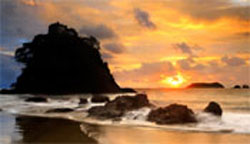 We are fortunate and grateful to have thoughtful and competent young men like those described above helping to protect us at the beach and doing so on a voluntary basis. Without their effort, those bad statistics quoted above would be much more negative and that beautiful beach depicted at sunset to the left would be considerably less than it currently is for both locals and tourists.
We are fortunate and grateful to have thoughtful and competent young men like those described above helping to protect us at the beach and doing so on a voluntary basis. Without their effort, those bad statistics quoted above would be much more negative and that beautiful beach depicted at sunset to the left would be considerably less than it currently is for both locals and tourists.
Thanks guys, you do a great job!
¡Excellente!
TOP
Travel Quote of the Month
"Writing allows me the time to travel and see the world,
which is what I always wanted to do.
I’d really like to have been Sir Richard Francis Burton,
but it’s the wrong century."
– Alan Dean Foster |
What's-in-a-Word
Monchito
"Monchito" of the lifeguards mentioned in the article above explained this one to me himself. There is no English equivalent of Monchito, Moncho is a nickname often used for Ramon, one of Monchito's real names. Monchito is a diminutive (oh how the Ticos love diminutives) of Moncho - hence it is equivalent to "little Moncho".
Juancho
This one is more embarrassing. Until I just looked it up, I thought Juancho was the Spanish equivalent of "Johnny". My dictionary now tells me that the common translation is "boyfriend, lover". Oops; I guess I'll be calling Johnny by his real name more often now (except that others tell me it's no big deal and Johnny laughs at the moniker).
TOP
ROMEO Corner
(Retired Old Men Eating Out)
Puerto Escondido, Manuel Antonio
Puerto Escondido was first reviewed in April 2012 - to see that review, go here: Escondido 2012.
Location: Across the Street from The Villabosque Hotel. From the Main Road to the National Park, Turn Left at the Marlin Restaurant, Go 200 Meters, Turn Left just before Hotel Villabosque and Go Straight Another 20 Meters. The Restaurant is Part of the Hotel Espadilla on the left.
Hours: 7 AM to 10 PM Sunday Through Monday
Parking: Ample at the Restaurant and the Hotel
Contact: Tel.: 2777-0903; Fax: 2777-5052; Email: hotel@espadilla.com; Web: www.espadilla.com
Reviewing ROMEOS: Ama L., Anita M., Jim B., Joe R., Lance M., Mary M. Bob N.
To Review Our Rating System and Procedure, go here: R.O.M.E.O. Rating System
The restaurant dining room hasn't changed much since our first review, some three years ago. It still presents itself as a very comfortable room with artful wall decorations (but with the hard bottom standard Tico wooden chairs that hurt GG's back), gentle lighting and surroundings of well manicured greenery on three sides. The tables are plain but this time included a tasteful runner on each table instead of the linen table cloths of yore. It's a nice place in the middle of the jungle to enjoy a quiet meal. We still give if five sloths for atmosphere.
It may be my memory failing once more but I believe the selection on the main menu has increased substantially since our last visit. There were a couple of dozen choices including chicken dishes, tuna filets and several beef lomitos (filets) prepared in various manners, even burgers.
GG took a seafood soup for a first course that included two types of mussels, squid, tiny shrimp, fish and something from the sea that was unidentified but delicious, as was the broth. Then I elected as a main course a very unusual lomito with an accent sauce of mint, chocolate and beet root (really). I tested it carefully but was very pleasantly surprised at how well these flavors blended and complimented the beef. It was served with some steamed broccoli tops, julienne carrots and small new potatoes. It was decorated with a few bougainvillea blossoms. Truly an outstanding dish, well presented.
|
 |
|
$$$$ |
Value Index = 125 |
Other ROMEOS selections included a chicken breast stuffed with shrimp, tuna steaks (one with a cheese/coconut covering with a wasabi accent) and a grilled chicken breast with vegetables cooked in a plantain leaf. Everyone reported their plate as being first quality food and tasty. For dessert, GG had a tropical fruit compote topped with a passion fruit sabayon and others had a coconut flan or cake. All agreed that, while the desserts were good, they didn't reach the same level of exceptionalism that the main courses had. We give Puerto Escondido five sloths for food quality and taste.
Our waiter, Luis, was pleasant and attentive to our needs even when a large tour group descended on the restaurant near the conclusion of our dinner. We also give Escondido five sloths for service and an overall rating of five sloths for atmosphere, food quality and service.
As usual, GG received the largest check. For the three courses of seafood soup, filet and sabayon dessert plus one coke and one coffee, the bill came to $44 including tax and legally required service charge (several of us left a little more). For this amount and quality of food, the bill is somewhat less than the top cost rating for Manuel Antonio and we give Puerto Escondido a cost rating of 4$. This yields a value index of 5/4x100=125, putting the restaurant in the top third of our value ratings.
For excellent food at a reasonable price, the ROMEO Group can easily recommend Puerto Escondido.
Golden Gringo Chronicles Novel and E-Books Now Available!
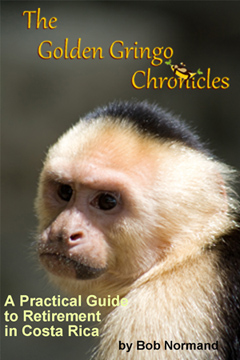 The story of the Golden Gringo Chronicles is also available as a hard copy novel of 192 pages available through Amazon and all major online retailers. ($9.95)
The story of the Golden Gringo Chronicles is also available as a hard copy novel of 192 pages available through Amazon and all major online retailers. ($9.95)
Amazon link: GGC, the Book. (Kindle Edition available)
Follow GG through the first six years of his odyssey in making the decision to retire in Costa Rica, overcoming the trials and tribulations of moving and obtaining residency there and the fun and experience of actually living in Ticoland.
en Gringo as he learns about the rich, varied culture of Costa Rica, the incredible bio diversity, the charming nature of the Costa Rican people and the ease with which a sometimes clueless ex-pat can assimilate into a small southwestern town on the Pacific coast.
Whether you are already a Costa Rican resident, someone contemplating a move here or just a traveler who enjoys different cultures, you will find the Golden Gringo Chronicles interesting, entertaining and informative about Costa Rica.
A narrative version of the Golden Gringo Chronicles is now also available as a trilogy of E-books in formats compatible with virtually all electronic platforms.
Part 1: (FREE!)
Leaving the Homeland
Part 2: ($3.99)
The Early Years
Part 3: ($3.99)
Becoming Tico, Maybe
Click on Part Number above for E-book sample downloads or click the price above right for purchase. (The best price is on Part 1; it's FREE)
Opt-In Here to Receive Your Free Copy Monthly
The Golden Gringo Chronicles is a free newsletter that is non-political, non-commercial and, hopefully, entertaining. By signing up you will receive an email each month around the first of the month giving you the links to the latest edition as well as to each feature and departmental section.
CLICK HERE TO SIGN-UP FOR THE
GOLDEN GRINGO CHRONICLES
or Email me at gg@goldengringo.com
The Golden Gringo
Pura Vida!
To Contact GGC World Headquarters (yuk, yuk) to make comments, suggest topics or criticize my bad jokes, just send an email to: bob@bobnormand.com.
Be pithy but kind; I'm sensitive.



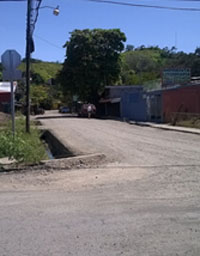
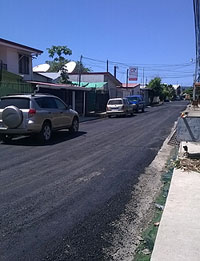
 Ostensibly, the project to build a $50 billion new canal in Nicaragua, designed to put it in direct competition to the Panama Canal, is going forward. The original cost estimate was $30 billion, then it was $40 billion, now it's $50 billion. In all likelihood it will be $100 billion should it really be constructed.
Ostensibly, the project to build a $50 billion new canal in Nicaragua, designed to put it in direct competition to the Panama Canal, is going forward. The original cost estimate was $30 billion, then it was $40 billion, now it's $50 billion. In all likelihood it will be $100 billion should it really be constructed.  An English-language online newspaper here recently reported that a ranking of presidential approval levels put our man Solis second to the bottom after Señor Maduro of Venezuela (see chart right).
An English-language online newspaper here recently reported that a ranking of presidential approval levels put our man Solis second to the bottom after Señor Maduro of Venezuela (see chart right). 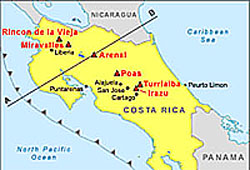
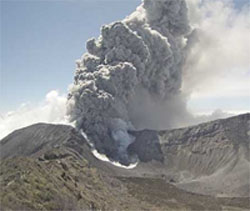
 The Chronicles published an article last month concerning a visit to the southern Nicoya (
The Chronicles published an article last month concerning a visit to the southern Nicoya (





 Even before his win of the writing contest, León set out to write a novel using pencils that were smuggled in to him. For stationary he used leftover cement bags. After ten years more and his eventual freedom he would produce his first best seller called La Isla de Los Hombres Solos (The Island of Lonely Men) all about his and other inmates' experiences at San Lucas. It remains his first significant writing and his signature work along with a second novel called "Tenochtitlan: The Last Battle of the Aztecs".
Even before his win of the writing contest, León set out to write a novel using pencils that were smuggled in to him. For stationary he used leftover cement bags. After ten years more and his eventual freedom he would produce his first best seller called La Isla de Los Hombres Solos (The Island of Lonely Men) all about his and other inmates' experiences at San Lucas. It remains his first significant writing and his signature work along with a second novel called "Tenochtitlan: The Last Battle of the Aztecs".



 GG learned early in life, around the age of 11 or 12 that large bodies of rapidly moving water are to be respected. Here's an example: once, he and some buddies decided to go swimming near where he lived in Massachusetts just one day after a hurricane had passed through the area. The waves were running 10-15 feet and looked like fun. At one point he was pulled out by a rip current and might have ended up as driftwood on a beach somewhere in New Jersey had it not been for an alert lifeguard who had no qualms about diving into the rough surf and snagging the hapless, struggling kid who would later become the Golden Gringo. Good job, amigo.
GG learned early in life, around the age of 11 or 12 that large bodies of rapidly moving water are to be respected. Here's an example: once, he and some buddies decided to go swimming near where he lived in Massachusetts just one day after a hurricane had passed through the area. The waves were running 10-15 feet and looked like fun. At one point he was pulled out by a rip current and might have ended up as driftwood on a beach somewhere in New Jersey had it not been for an alert lifeguard who had no qualms about diving into the rough surf and snagging the hapless, struggling kid who would later become the Golden Gringo. Good job, amigo. Death by drowning is more common than some people might think. According to the World Health Organization: "Drowning is the 3rd leading cause of unintentional injury death worldwide, accounting for 7% of all injury-related deaths. There are an estimated 372,000 annual drowning deaths worldwide." Some drowning "rates" for selected countries are shown on the table to the left.
Death by drowning is more common than some people might think. According to the World Health Organization: "Drowning is the 3rd leading cause of unintentional injury death worldwide, accounting for 7% of all injury-related deaths. There are an estimated 372,000 annual drowning deaths worldwide." Some drowning "rates" for selected countries are shown on the table to the left. 
 We are fortunate and grateful to have thoughtful and competent young men like those described above helping to protect us at the beach and doing so on a voluntary basis. Without their effort, those bad statistics quoted above would be much more negative and that beautiful beach depicted at sunset to the left would be considerably less than it currently is for both locals and tourists.
We are fortunate and grateful to have thoughtful and competent young men like those described above helping to protect us at the beach and doing so on a voluntary basis. Without their effort, those bad statistics quoted above would be much more negative and that beautiful beach depicted at sunset to the left would be considerably less than it currently is for both locals and tourists.

